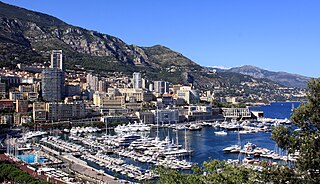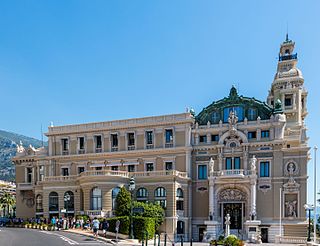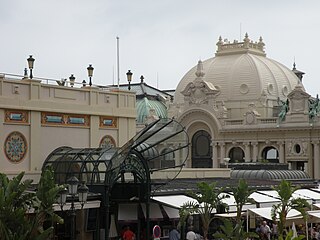
Monaco, officially the Principality of Monaco, is a sovereign city-state and microstate on the French Riviera a few kilometres west of the Italian region of Liguria, in Western Europe, on the Mediterranean Sea. It is bordered by France to the north, east and west. The principality is home to 38,682 residents, of whom 9,486 are Monégasque nationals; it is widely recognised for being one of the most expensive and wealthiest places in the world. The official language is French, although Monégasque, Italian and English are spoken and understood by a sizeable group.

Transport in Monaco is facilitated with road, air, rail, and water networks. Rail transport is operated by SNCF and its total length is 1.7 km. Monaco has five bus routes operated by Compagnie des Autobus de Monaco. There are also two other bus routes which connect Monaco with neighboring regions such as Nice and Menton.

Monte Carlo is officially an administrative area of the Principality of Monaco, specifically the ward of Monte Carlo/Spélugues, where the Monte Carlo Casino is located. Informally, the name also refers to a larger district, the Monte Carlo Quarter, which besides Monte Carlo/Spélugues also includes the wards of La Rousse/Saint Roman, Larvotto/Bas Moulins and Saint Michel. The permanent population of the ward of Monte Carlo is about 3,500, while that of the quarter is about 15,000. Monaco has four traditional quarters. From west to east they are: Fontvieille, Monaco-Ville, La Condamine, and Monte Carlo.

The Opéra de Monte-Carlo is an opera house which is part of the Monte Carlo Casino located in the Principality of Monaco.

La Condamine is the central Ward in the Principality of Monaco. Its landmarks include Port Hercules, the Rainier III Nautical Stadium, and the Princess Antoinette Park. Its farmer's market at the Place d'Armes dates from 1880 and is a great source of local pride for its "authentic Monegasque" essence.

Charles III was Prince of Monaco and Duke of Valentinois from 20 June 1856 to his death. He was the founder of the famous casino in Monte Carlo, as his title in Monegasque and Italian was Carlo III. He was born in Paris, the only son of Florestan, Prince of Monaco, and Maria Caroline Gibert de Lametz.

Beausoleil is a commune in the Alpes-Maritimes department in the Provence-Alpes-Côte d'Azur region in Southeastern France. It adjoins the Principality of Monaco to the north. The commune of Beausoleil was established in 1904; it was supposed to be named Monte-Carlo Supérieur for a time but the idea was abandoned after protests from Monégasque authorities. In 2017, it had a population of 13,607.
Trams in Cannes was a tram public transit system in the French city of Cannes. The tramway opened in 1900 and ended operation in 1933.

Trams in Nice was the first-generation tramway system serving the city of Nice, France, which operated from 27 February 1879 to 10 January 1953.

The Principality of Monaco has currently a single railway station, Monaco - Monte Carlo, part of the Marseille–Ventimiglia railway line. The station was originally opened in 1867, but extensively rebuilt in 1999. The length of railway within the Principality is 1.7 km (1.1 mi), giving Monaco the third-smallest railway system in the world.

The Monte Carlo Casino, officially named Casino de Monte-Carlo, is a gambling and entertainment complex located in Monaco. It includes a casino, the Opéra de Monte-Carlo, and the office of Les Ballets de Monte-Carlo.
AREP is a multidisciplinary consultancy that is wholly owned by SNCF. It was formed in 1997 by Jean-Marie Duthilleul and Étienne Tricaud, architects and engineers. It has 600 staff from around 15 countries, including town planners, architects, engineers, economists, technicians, designers, and project managers.
The Société des Bains de Mer, officially the Société Anonyme des Bains de Mer et du Cercle des Etrangers à Monaco, is a publicly traded company registered in the Principality of Monaco. SBM manages and owns the Monte Carlo Casino, the Opéra de Monte-Carlo, and the Hôtel de Paris in Monte Carlo.

Monaco-Monte-Carlo station is the sole railway station in the Principality of Monaco, though part of it is located in Beausoleil, France. It is served by trains of the French state-owned operator SNCF, on the Marseille–Ventimiglia railway line. The station, along with the entire railway line in the principality, is located underground.
The Monte-Carlo Pavilions, also known as the Pavillons des Merveilles and the Pavillons des Boulingrins, are five temporary commercial buildings in Monaco.

Monaco is known for its wide range of architecture for a small country. The geography of Monaco, which consists of sharp hills and narrow coastline, influences the Monacan architecture. The narrow roads have led to architectural construction being built into the hills in limited amounts of space. This limited space has, more recently, the issue of construction in Monaco has created social disruption.

Marie Charlotte Blanc was a German socialite and businesswoman. She was a prominent member of high society in Monaco and France. After the death of her husband, François Blanc, she operated the Monte Carlo Casino.

The Café de Paris is a coffeehouse and restaurant in the Belle Époque style of the 1900s, located in Monte Carlo and next to the Casino de Monte-Carlo, on the Place du Casino, facing the Hôtel de Paris. It is owned and managed by the Société des bains de mer de Monaco.

Compagnie des Autobus de Monaco (CAM) is the main public transport operator in Monaco. The company operates 6 regular bus lines, a night service, the Boat-Bus service and several school reinforcements.













